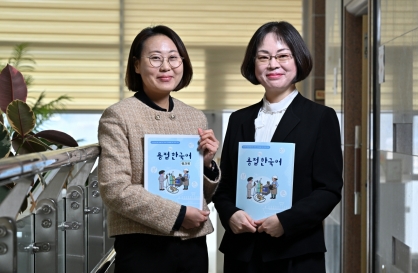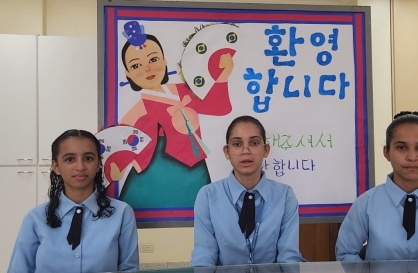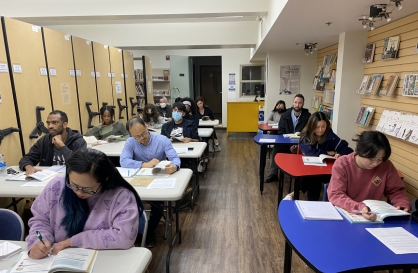Most Popular
Hello Hangeul
-
1
Welding book first in vocational Korean series for foreign labor

-
2
[Korea Beyond Korea] In Sao Paulo, horizons expand for Korean studies
![[Korea Beyond Korea] In Sao Paulo, horizons expand for Korean studies](//res.heraldm.com/phpwas/restmb_idxmake.php?idx=644&simg=/content/image/2023/11/20/20231120000619_0.jpg&u=20231206104853)
-
3
In Brasilia, worldly dreams are born from Korean classes

-
4
Americans seeking to visit Korea learn the language in LA

-
5
[Korea Beyond Korea] Berlin, Europe's Korean Studies hub, nurtures next-gen experts, scholars
![[Korea Beyond Korea] Berlin, Europe's Korean Studies hub, nurtures next-gen experts, scholars](//res.heraldm.com/phpwas/restmb_idxmake.php?idx=644&simg=/content/image/2023/10/18/20231018000929_0.jpg&u=20231023154735)
[Hello Hangeul] The linguistic divide of Korea: the legacy of 'Malmoi' and decades of separation
Efforts to compile the first Korean dictionary in the early 1900s gave two Koreas the same foundation
By Park Ga-youngPublished : Feb. 26, 2023 - 17:33

Choi Seol, a North Korean defector, entered a stationery shop to purchase a stapler. She asked for "chaekjjipkke" -- which literally means bookbinder – as it was the only word she knew to refer to the stationary item. The store clerk was puzzled, and Choi left the store empty-handed after a few minutes of explaining what she wanted. Later, she learned that South Koreans refer to staplers as "hotchkiss," a Japanese loanword.
She also recalls a conversation with a colleague, in which the word "peuraideu" was used, piquing her curiosity. Later, she looked up the meaning of the word and discovered that it was referring to the English word "pride."
The gap in languages between the two halves of one whole has become profound due to the ongoing partition of the peninsula for almost 80 years.
These differences are not confined to the occasional loanword, but span the breadth of the lexicon, including grammar, spelling, pronunciation and the influence of foreign languages, even including the order of words in the dictionary.
After years of turmoil that led to an impasse and divided Korea into two parts, North Korea’s focus on simplifying everyday vocabulary has been considered a strategy to use language as a tool for propaganda and reinforce its national identity as distinct from South Korea. Therefore, eliminating many words that have roots in Japanese and Chinese characters served a purpose beyond the cultural and etymological.
While South Koreans refer to smartphones as "seumateupon," an expression borrowed from English, North Koreans call it "sonjeonhwa," meaning handheld phone in Korean.
This is just one example of many North Korean words that came into existence due to the necessity of labeling new things or concepts using purely Korean words. Additionally, the availability of words also reveals the hermitic nature of North Korea and its distance from international trends.
South Koreans, on the other hand, are more familiar with borrowed words, with many words that maintain the same or similar pronunciation as their language of origin, such as "diyeoteu" (diet), "dakeumenteori" (documentary), "rekodeo" (recorder), "kaempein" (campaign), "paiting" (a word of encouragement, similar to "fight on" or "cheer up"), "saendeuwichi" (sandwich), "helseu" (health or fitness), "keompyuteo" (computer), "taeksi" (taxi), "maseukeu" (mask), "syopingmol" (shopping mall), "beoseu" (bus), "kape" (cafe), and more.
Some words are a clear reflection of the different social systems in each of the Koreas, such as the words Korean Peninsula vs. Joseon Peninsula, or city hall vs. the People's Committee Office.

The words "buja," "sinsa," and "gwibuin" in Korean typically refer to a rich person, gentleman and noblewoman, respectively. However, in North Korea, these same words can carry negative connotations, referring to exploitative or idle individuals who are seen as contributing little to society. In North Korean society, the term "buja" is often associated with corrupt officials or wealthy individuals who have gained their wealth through illicit means. Similarly, "sinsa" can be used to describe someone who is idle or carefree, while "gwibuin" may be used to refer to women who are seen as frivolous or lacking in substance.
The biggest difference stems from the social and political developments that occurred after the division between the South and North.
For instance, "mukbang," "PC bang" and "skinship" are some of the 26 South Korean words that were officially added to Oxford English Dictionary in 2021. They would be strange to North Koreans, despite their international recognition as decidedly "Korean" words.
Villages known as "daldongne," whose literal meaning is “moon village,” would be foreign to North Koreans as well. While the literal meaning of the words may be transferable across the Korean divide, their hidden connotations may be elusive for those who hail from the other side of the Demilitarized Zone. “Moon village” is used to describe a type of urban slum or shantytown, usually on the hills. For Choi, the North Korean defector and scholar, “moon village” sounds romantic and poetic.
Similarly, the term "8.3 couple," meaning an unfaithful couple for North Koreans, is something South Koreans most likely wouldn't understand without knowing the context. The term originated from August 3, 1984, when North Korean leader Kim Jong-il instructed people to make daily necessities using byproducts from factories and enterprises, a departure from the country's central planning. Over time, the term "8.3" became associated with fake, counterfeit, or low-quality products, as products made using byproducts were often of poor quality. Thus, the term "8.3 couple" has taken on a negative connotation, implying that the couple's relationship is similarly fake or of low quality.
The concepts of bank loans, credit cards, convenience stores and social media barely exist in the world of North Korea. As a result, there are no frequently used local terms to refer to them in the language. The language gap between South and North Korea extends beyond everyday technology and consumer goods to include professional areas such as IT and medicine. The lack of development in these fields in North Korea has created a significant linguistic gap, which is a concerning issue, according to Kim Gang-chul, Deputy Chief of the Joint Board of South and North Korea for the Compilation of Gyeoremal-Keunsajeon, an unabridged and unified Korean dictionary.

"Malmoi" in the 21st century
In 2005, in an attempt to bridge this divide, a joint committee was established to write and publish a grand dictionary encompassing the Korean language in both of its forms. They agreed that it would be 307,000 words in scope, and met 25 times until 2015 by which point they had agreed on 128,000 words. Since then, 8 years have passed since the last proper discussion and the project has been in limbo.
The South Korean team has taken it upon themselves to create a temporary version of "Gyeoremal-Keunsajeon" to present to their North Korean counterparts. Kim said the committee hopes this 10-book set serves as a bridge between the two Koreas and can speed up as soon as the communication resumes.
Kim pointed out that the difference would have been much more significant if it were not for the tireless efforts of linguists in the 1930s who not only strived to preserve local dialects, but also managed to compile over 16,000 Korean-language manuscripts for the first Korean dictionary. Called "Malmoi," the dictionary is based on the Korean word “malmo,” which means “collecting words.” The dictionary came at a time when the use of the Japanese language was imposed on Korea during the colonial era of 1910-1945.
Their efforts are depicted in the 2019 movie “Mal-Mo-E: The Secret Mission.”
While some of the characters and story are fictional, the efforts and hurdles depicted in the journey to publishing a comprehensive dictionary are all too real. Thirty-three members of the Korean Language Society who were working on the dictionary were imprisoned until the country was liberated in 1945, while two died by torture. The dossiers of words, which were meant to be used as evidence against the members during trials, were discovered at Seoul Station a few years later and became the foundation for initial dictionaries published in South and North Korea, according to Kim.
"I think it's natural for the reunification of North and South to eventually lead to the unification of our languages, whether it happens suddenly or gradually. And there will certainly be confusion during this process," Kim said. "If we want to minimize the duration of the confusion and its aftereffects, we need tools and measures that can help with integration and act as buffers, just like 'Malmoi' did."






![[Herald Interview] How Gopizza got big in India](http://res.heraldm.com/phpwas/restmb_idxmake.php?idx=644&simg=/content/image/2024/11/20/20241120050057_0.jpg&u=20241120164556)

![[KH Explains] Dissecting Hyundai Motor's lobbying in US](http://res.heraldm.com/phpwas/restmb_idxmake.php?idx=644&simg=/content/image/2024/11/20/20241120050034_0.jpg&u=)

![[Kim Seong-kon] Farewell to the vanishing John Wayne era](http://res.heraldm.com/phpwas/restmb_idxmake.php?idx=644&simg=/content/image/2024/11/19/20241119050096_0.jpg&u=)
![[Graphic News] 70% of S. Koreans believe couples can live together without tying the knot: survey](http://res.heraldm.com/phpwas/restmb_idxmake.php?idx=644&simg=/content/image/2024/11/19/20241119050098_0.gif&u=)

![[Korea Beyond Korea] In Sao Paulo, horizons expand for Korean studies](http://res.heraldm.com/phpwas/restmb_idxmake.php?idx=644&simg=/content/image/2023/11/20/20231120000619_0.jpg&u=20231206104853)


![[Korea Beyond Korea] Berlin, Europe's Korean Studies hub, nurtures next-gen experts, scholars](http://res.heraldm.com/phpwas/restmb_idxmake.php?idx=644&simg=/content/image/2023/10/18/20231018000929_0.jpg&u=20231023154735)







![[Today’s K-pop] Blackpink’s Jennie, Lisa invited to Coachella as solo acts](http://res.heraldm.com/phpwas/restmb_idxmake.php?idx=642&simg=/content/image/2024/11/21/20241121050099_0.jpg&u=20241121172748)